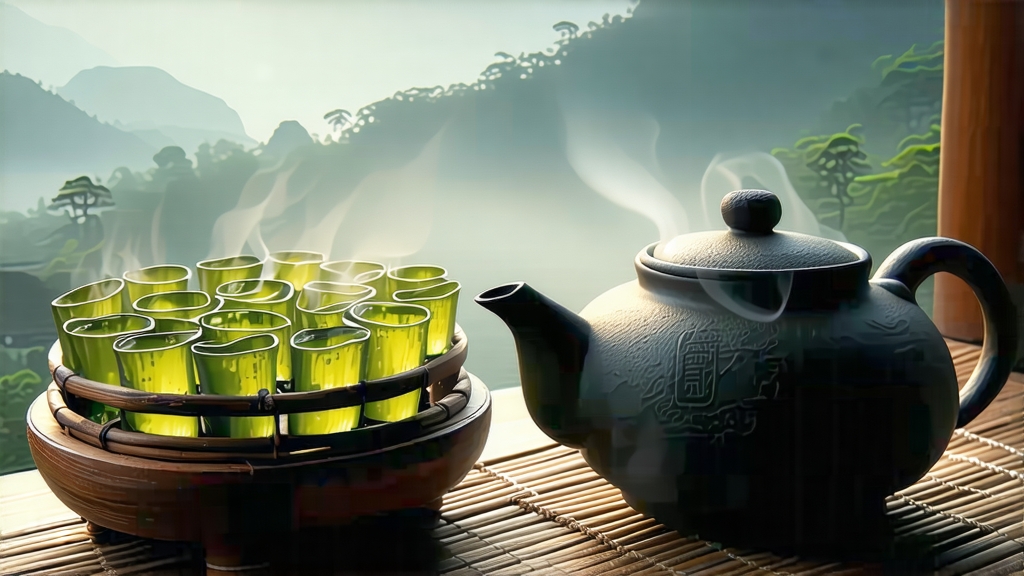
Among the pantheon of Chinese green teas, few names evoke as much poetry in miniature as Biluochun. Literally “Green Snail Spring,” the tea is prized for its tiny spiral-shaped leaves, downy silver tips, and a fragrance so naturally sweet that early Qing-dynasty poets claimed it could “steal the scent of ripe peaches from neighboring orchards without a single blossom in sight.” Grown almost exclusively on the mist-laden slopes of East and West Dongting Mountain in Lake Tai, Jiangsu Province, Biluochun is both a geographical indication and a cultural heirloom, a living testament to how terroir, history, and human ingenuity can be rolled—quite literally—into one perfect curl.
Historical whispers place Biluochun’s birth during the late Ming dynasty, when a tea-picking nun roaming the Dongting peaks noticed wild tea trees whose tender buds exuded an arresting fruity aroma. She plucked a handful, sun-dried them on her bamboo hat, and later brewed the leaves for the local magistrate. The infusion so astonished the official that he christened the tea “Xia Sha Ren Xiang”—“Scary Fragrance”—for its almost supernatural perfume. When the Kangxi Emperor visited Lake Tai in 1699, court chroniclers record that he found the name inelegant and rechristened it Biluochun, referencing the tight snail-like roll and the season of earliest harvest. Imperial patronage catapulted the tea into tribute status; for the next two centuries, every spring, the fastest barges raced down the Grand Canal to deliver the first kilo of Biluochun to the Forbidden City before the Qingming festival.
Today, the cultivar pool remains narrow and fiercely protected. Only four clonal selections—Dongting Qunti, Dongting Wu, Xianghu, and Jinfeng—are permitted under the national Geographical Indication standard. Each bush is grafted, not seeded, to preserve the subtle genetic markers that translate into Biluochun’s signature honeysuckle-peach nose. The plants are intercropped with peach, plum, and loquat trees; fallen fruit petals decompose into the acidic, well-draining purple-brown soil, while the lake’s morning mist refracts sunlight into a soft, diffused glow that slows photosynthesis and concentrates amino acids, especially L-theanine. The result is a leaf chemistry that balances grassy sweetness with a lingering marine umami—what local farmers call “lake air flavor.”
Plucking begins when the mercury hovers between 12–15 °C, usually two weeks before Qingming. Only the “sparrow’s tongue”—a bud just beginning to unfurl into a single leaf—is acceptable. Experienced pickers can harvest 600 grams of fresh leaf in an hour, yet that yields a mere 120 grams of finished tea. The plucked shoots are carried in shallow bamboo trays to prevent compression; within two hours they must reach the village workshop, where the 10-step craft begins with gentle withering under diffused light. Unlike pan-fired green teas, Biluochun is entirely wok-tossed, a technique known as “qing guo” or green wok. The iron vessel is pre-seasoned with fresh tung-oil and tea-seed oil to create a micro-layer of polymerized fat that prevents sticking while imparting a whisper of nuttiness. The master first sets the wok to 180 °C, tossing the leaves for precisely 45 seconds to kill green enzymes; the temperature is then dropped to 80 °C for the rolling phase. Using only the heel of the palm and a bamboo hand-shield, the tea maker applies a spiral pressure—clockwise, then counter-clockwise—coaxing the leaf into its iconic tight curl while rupturing only 30 % of cell walls to release aromatic oils without excessive astringency. The final drying is done over a charcoal brazier fed with dried bamboo and young peach branches, imbuing a faint stone-fruit smoke that accentuates rather than masks the tea’s innate sweetness.
Grading follows a 1-to-7 scale based on bud density, downy coverage, and infusion clarity. Special Grade I, harvested before March 20, displays a jade-green curl flecked with silvery trichomes; when dropped into a porcelain gaiwan, the leaves stand upright for a brief second—what connoisseurs call “the dancing shrimp.” Lesser grades, picked after April 5, unfurl into larger, darker fragments and lack the buoyant fruit lift. Regardless of grade, all